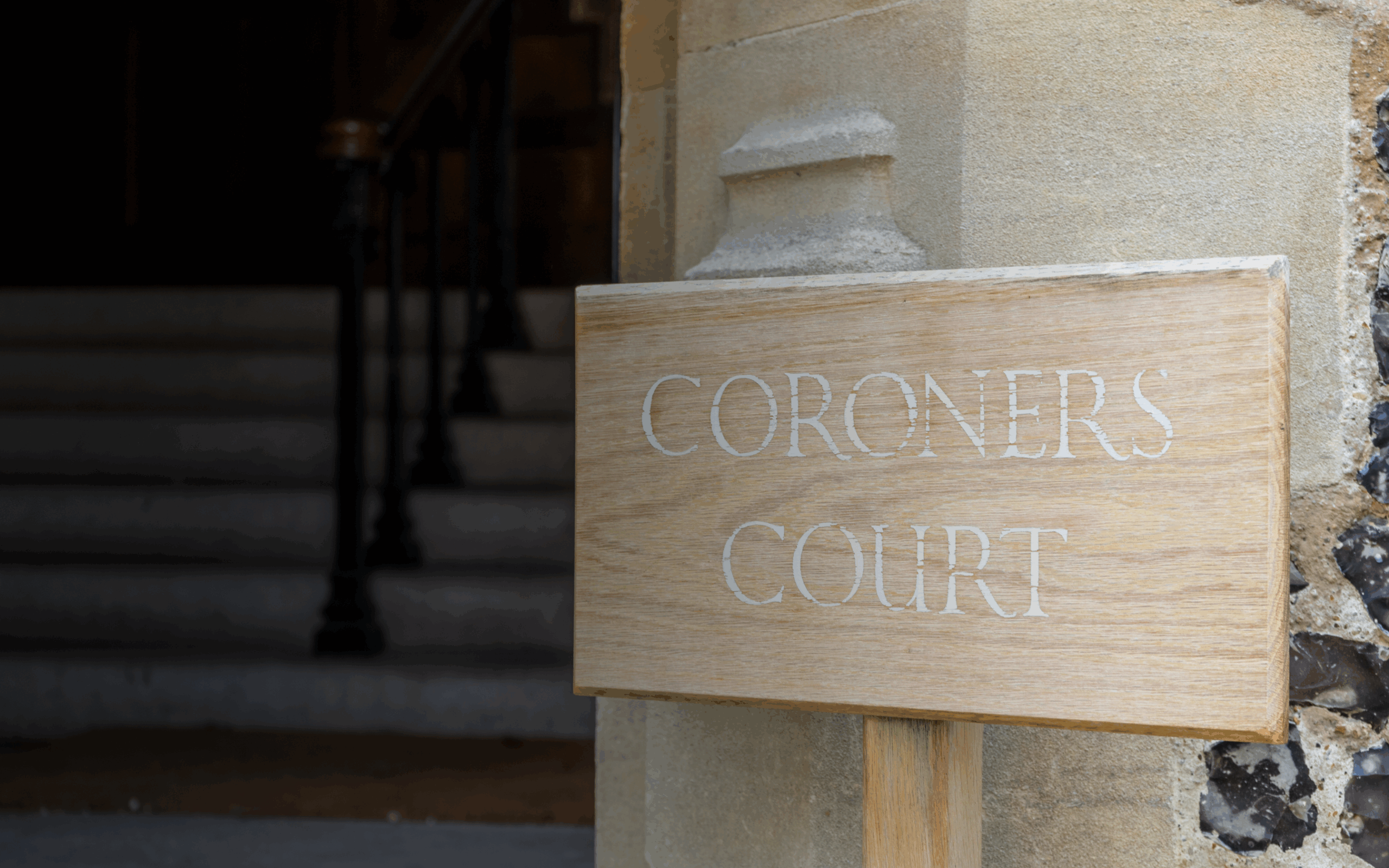The recent suspension of the Sky Lewis inquest has brought fresh scrutiny to Rule 25(4) of the Coroners (Inquest) Rules 2013, which obliges a coroner to notify the Director of Public Prosecutions when a death is “likely” due to a homicide offence.
Lewis Harrison, a barrister at 30 Park Place, examines the uncertainty around the threshold for triggering this duty, considers relevant case law, and argues that a lower predictive standard—rather than the balance of probabilities—best safeguards both coronial neutrality and the rights of those potentially facing criminal charges.
The Senior Coroner for Pembrokeshire and Carmarthenshire has recently exercised his duty under Rule 25(4) of the Coroners (Inquest) Rules 2013 to suspend the inquest touching upon the death of Sky Lewis and notify the Director of Public Prosecutions that it appeared to him that the death was likely due to a homicide offence.
Christian J Howells (30 Park Place) and I represented the family during a three-week inquest and submitted that the threshold for adjourning and notifying the DPP had been met because of evidence of corporate manslaughter by her children’s home, where she had been placed for the purposes of psychological therapy.
Rule 25(4) obliges a Coroner to adjourn the inquest and notify the DPP “if during the course of the inquest, it appears to the Coroner that the death of the deceased is likely to have been due to a homicide offence and that a person may be charged in relation to the offence”.
The question arises, however, as to how a Coroner should interpret the phraseology within the rule; specifically, how one should interpret “likely”.
Moreover, it gives rise to ambiguity around which interpretation gives proper efficacy to the rule, in a way that protects Coroners against; firstly, impinging upon their prohibition under s. 10(2) of the Coroners and Justice Act 2009 not to frame their conclusions in a way that appears to determine the issue of i) criminal liability on the part of a named person, and ii) civil liability; and secondly, making factual determinations before concluding their investigation.
For the avoidance of doubt, this article will make no reference to any evidence heard at the Sky Lewis Inquest and shall not comment upon the evidence in anyway.
The Purpose of Rule 25(4)
The purpose of adjourning the inquest in such circumstances is, in part, to ensure that as little prejudice as possible attaches to any person suspected of involvement in the person’s death, and moreover, to ensure that coronial proceedings remain neutral and do not become accusatorial. [1]
The duty requires the Coroner to keep under review whether the evidence crosses the threshold for referral to DPP. This exercise is a fine balancing act. The Coroner will need to balance whether there is the sufficiency of evidence to refer the matter to the DPP, which in and of itself if done brings obvious connotations to any person(s) likely to be accused, against the risk of prejudice of evidence being adduced which will unfairly prejudice any suspected person. [2]
Jervis on Coroners (15th Edition) provides a helpful summary from the Home Office Circular No. 187 of 1977
“…the Home Office suggested that, once the coroner is aware that the inquest, if continued, is likely to lead to a serious suggestion of guilt against an individual, the duty to adjourn and refer the matter should be engaged…” [3]
The purpose of the rule is clear; however, where is the threshold for Rule 25(4)?
What is the Threshold for Rule 25(4)?
There is no standardised definition for the term ‘likely’. Therefore, should the context of the statutory obligation inform the standard of proof required? I would suggest, yes.
R(Maughan) v Oxfordshire Senior Coroner [2020] UKSC 46, [2021] AC 454 at §93 established that a conclusion of unlawful killing within a coronial inquest is made to the civil standard, not the criminal standard.
Maughan informs the determination in R(on the application of Glaister and Carr) v HM Assistant Coroner for North Wales (East and Central) [2025] EWHC 167 Admin which, at §82, considered that a conclusion on the balance of probabilities of unlawful killing by means of gross negligence manslaughter did not amount to a determination of criminal or civil liability for the purpose of s. 10(2) of the Coroners and Justice Act 2009.
It is within this context that ambiguity arises as to when Rule 25(4) is engaged. Should “likely” be interpreted as meaning on the balance of probabilities or should it be a lower standard?
Given the application of Rule 25(4) occurs i) prior to the Coroner’s conclusion and ii) often prior to the conclusion of hearing evidence, it follows that the application should not require the Coroner to make any factual and/or final determinations. To reach a conclusion without considering all the evidence would be not only inappropriate, but also highly prejudicial.
Logically, the exercise of Rule 25(4) requires a prospective rather than retrospective determinative outlook.
Unfortunately, there is no caselaw regarding the application of this specific duty. However, the case of Boyle v SCA Packaging Ltd (Equality and Human Rights Commission intervening) [2009] UKHL 37, [2009] I.C.R 1056 provides arguably the most applicable guidance.
Boyle appeared before the House of Lords following an appeal from the Court of Appeal (Northern Ireland) in respect of, inter alia, the statutory definition of “likely” within paragraph 6(1) of Schedule 1 of the Disability Discrimination Act 1995. Paragraph 6(1) reads:
An impairment which would be likely to have a substantial adverse effect on the ability of the person concerned to carry out normal day-to-day activities, but for the fact that measures are being taken to treat or correct it, is to be treated as having that effect
Lord Rodger in Boyle at §35-36 agreed with the definition in the context of the DDA 1995 that ‘likely’ should be interpreted as “it could well happen” rather than “probable”. He further helpfully identifies the comments of Lord Nicholls in Cream Holdings Ltd v Banerjee [2005] 1 AC 253: “as with most ordinary English words ‘likely’ has several different shades of meaning. Its meaning depends on the context in which it is used”.
At §69-72 in Boyle, Lady Hale concludes that within the context of the DDA 1995, there is very good reason for concluding that parliament would not have intended “likely” to mean “more likely than not”. At §70 Lady Hale states: “But predictions are very different from findings of past fact. It is not a question of weighing the evidence and deciding whom to believe. It is a question of taking a large number of different predictive factors into account”.
Lady Hale endorsed the analysis of Girvan LJ previously in the Court of Appeal [2009] IRLR 54 at §19: “The prediction of medical outcomes is something which is frequently difficult. There are many quiescent conditions which are subject to medical treatment or drug regimes and which can give rise to serious consequences if the treatment or the drugs are stopped. These serious consequences may not inevitably happen and in any given case it may be impossible to say whether it is more probable than not that this will occur. This being so, it seems highly likely that in the context of paragraph 6(1) in the disability legislation the word ‘likely’ is used in the sense of ‘could well happen’.”
Boyle’s analysis offers a useful analogy as to how Coroners should apply Rule 25(4). The Coroner is required to exercise a predictive analysis and therefore applying a lower threshold would be more appropriate.
The Senior Coroner for Pembrokeshire and Carmarthenshire in the Sky Lewis inquest accepted the analysis inline with Boyle. The Senior Coroner made no comments on the evidence.
Conclusion
Without a line of authority dealing with the application of Rule 25(4), the issue of when the duty is triggered may remain a subject of debate. However, to my mind, the application of a lower test as applied in Boyle best protects a Coroners’ position in so far as any future conclusions they might draw if the matter is returned to them from the DPP. Moreover, the application of a lower test safeguards persons at risk of criminal charges from being prejudiced by the evidence heard at the inquest.
A lower threshold than the balance of probabilities does not require the Coroner to prematurely finalise their conclusion.
Put differently, were the true interpretation of Rule 25(4) that the Coroner must be satisfied on the balance of probabilities that a homicide offence had been the cause of death, Rule 25(4) would have no real function. To have any function, the rule must require the Coroner to adjourn the inquest prior to their conclusion. If the true standard of proof were the balance of probabilities, following the cases of Maughan and Glasiter and Carr, the rule could only ever be evoked at the end of an inquest; thus having no practical function.
The application of a lower threshold i) preserves the neutrality of a coronial investigation, ii) safeguards against prejudicing persons likely to be accused of a homicide offence, and iii) does not fetter the Coroner’s future ability to make decisions on the balance of probabilities whether the death was caused by unlawful killing should the DPP not seek to investigate and/or consents to the resumption of the inquest.
_____
[1] Home Office Circular No.187 of 1977, App.C para.8; Jervis on Coroners (15th Ed.) para 11-48
[2] Jervis on Coroners (15th Ed.) para 11-49
[3] Jervis on Coroners (15th Ed.) para 11-49.



